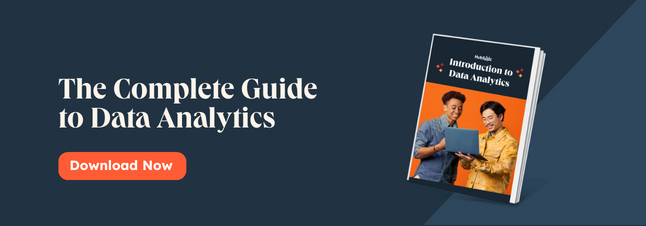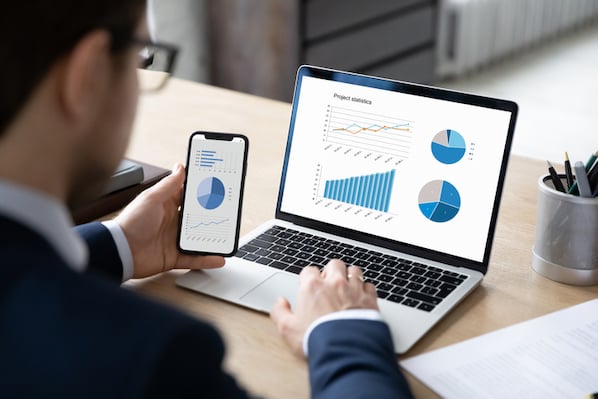Any data that has to do with your business can be mined. This data includes but is not limited to:
- Revenue
- Raw number of sales
- Raw number of customers
- Raw number of customers who’ve churned
- Raw number of customers in a certain geographical area
- Marketing spend
- And much, much more
Feeling overwhelmed? That’s understandable. Most businesses wish they could take better advantage of their data to make better, more informed decisions — but that is much easier said than done.
Big data is a veritable gold mine in what it has to offer, but managing, analyzing, and deriving insights from it presents a lot of challenges, too. And when you start learning about data management, you come across all this technical jargon and complex definitions that seem to make it all the more complicated.
That’s where data mining comes in. It takes everything that’s overwhelming about analyzing and managing big data and makes it much more accessible and easier to understand.
How Data Mining Works
Data mining can give you important insights that solve problems, reduce risks and costs, identify market opportunities, improve customer experience, and predict customer behaviors and preferences.
Before we dive into the more tactical aspects of data mining, let’s take a look at the benefits.
When done well, data mining can bring a significant advantage by providing business intelligence you wouldn't otherwise have access to. It also gives you insights in a much more relevant and timely manner. Some of the benefits of data mining include:
1. It allows you to easily find the most important data.
Big data has some really useful information in it, but there's also a lot you don't need and that would hinder analyses rather than help. Data mining allows you to automatically tell the valuable information apart and construe it into actionable reports.
If you’re using a tool such as Operations Hub to track your data, you often don’t have to look at the raw numbers at all or create reports from scratch each time. Instead, you can find your most pertinent data each time you access the tool, negating the need to export and compile spreadsheet after spreadsheet of raw numbers.
2. It results in faster, automated decision-making.
Instead of needing a person to review everything and decide on a course of action, you can automate certain decisions. For example, banks can use software to identify data trends that look like fraudulent behavior and automatically block accounts within seconds, notify a responsible individual, or request additional verification from users.
Even if you have a person manually reviewing the data, you can speed up the decision-making process by having data mining processes in place that turn the big data into more digestible fragments.
3. It helps your team work more efficiently.
Imagine having your sales team review a 100-tab spreadsheet every time they want to find the number of customers in a certain industry. Data mining takes all of this manual work out of the equation by providing a way for salespeople to find this information without wading through rows and rows of big data.
There are hundreds of use cases where data mining will serve both managers and individual contributors in a team. If your job is to find patterns and trends in a data set, data mining will help you do that effortlessly.
4. It helps you gather accurate data about your customers.
Data mining can help you gather customer data from multiple sources and collate it to form informative and thorough profiles. This can give you valuable knowledge about customer trends, preferences, behaviors, similarities, and differences. That's the type of information that helps you deliver a better customer experience overall and improve communication across all touchpoints.
5. It helps you increase revenue.
With the knowledge you get from data mining, you can build much more personalized sales pitches, create better campaigns, and tailor content and product recommendations based on known customer preferences and behaviors.
You can also predict trends in how consumers purchase or navigate your website, figure out what stops them from buying or what leads them to churn, create accurate audience segments, and offer tailored promotions. It goes without saying that these data-driven changes yield a significantly higher ROI, increasing revenue.
Now that you know the benefits of data mining, let’s take a look at some techniques you can use to get started.
Data Mining Techniques

You can get started data mining without needing a data analyst on your staff roster. We’ll start with some basic techniques, then move on to more specialized processes.
- Data Warehousing: Data warehousing refers to the systems you use to store all of your business’s data. This can include spreadsheet tools, servers, and dedicated dataset software. Data warehousing is the backbone of a strong data mining process.
- Data Cleansing and Preparation: This is the next most important data mining technique. The information stored in your data warehouse must be duplicate-free and error-free, and must also be adaptable to different formats. Keeping your data quality high is essential in data mining, or you risk finding false trends and patterns.
- Association: Association refers to the process of finding correlations, and even causality, between different types of data. For instance, if your customers in a certain industry almost always buy a certain product, associating the two could help you create stronger pitches later.
- Classification: Classification is the straightforward process of putting your data in buckets based on specific shared qualities and characteristics. The most challenging aspect of classification is determining which categories you should place your data into.
- Regression: Regression is a data mining technique used to predict a number — for example, the price of an item — based on certain factors, characteristics, or data points. For instance, if you wanted to predict the price of a house, you might take into account the neighborhood, plot size, and more.
- Data Analytics: In data mining, data analytics refers to the process of turning raw data into insights that can help you make better business decisions. While you can use a wide variety of tools for data analytics, the most common ones include dashboard software and business intelligence reporting tools.
- Clustering: Similar to classification, clustering is the process of loosely putting data in buckets based on similarities. The difference between classification and clustering is that classification requires you to create categories, while clustering is more about finding similarities regardless of category.
An often overlooked step when implementing data processes — including data mining — is data integration. In a nutshell, data integration means combining data from several disparate sources into a unified database for a more consistent view of the data. It’s one of the most important steps in data lifecycle management (DLM).
Advanced Data Mining Techniques
For the following techniques, you might need a data analyst who knows how to use AI and machine learning tools to further refine the data mining processes at your business.
- Artificial Intelligence: More of a tool and less of a technique, artificial intelligence systems can help you use speech recognition and natural language processing to glean insights from large datasets and help you classify and associate them.
- Machine Learning: In data mining, machine learning refers to the process of programming a software or computer to predict future patterns and behaviors, without being explicitly programmed to do so. A data analyst can use the Python and R programming languages to use machine learning in a data mining context.
- Association Rule Learning: Association rule learning mixes basic association, which we covered in the previous section, and machine learning to find patterns within your dataset. If the patterns keep occurring, this is called an “association rule.”
How to Data Mine
Data mining may sound like something only an enterprise firm can do, but any company can do it, so long as you approach it in stages. For that, we recommend using CRISP-DM (Cross Industry Standard Process for Data Mining). It’s comprised of six stages:
- Business Understanding
- Data Understanding
- Data Preparation
- Modeling
- Evaluation
- Deployment
We break these down below.
Stage 1: Business Understanding
In this stage, your job is to figure out what your company is trying to get out of this data mining project. Is it to increase revenue? Find better prospects? Attract top talent? Create more profitable marketing campaigns? It can truly be anything, so long as you can arrive to an answer by analyzing data.
Stage 2: Data Understanding
Next up, it’s time to identify the datasets you need to answer your question. For instance, if your goal is to increase revenue, you might need the current number of customers, the number who has churned, and the average deal size.
Gather your high-quality data and store it in a format that you can easily access. If you’re just getting started with data mining, you might use something as simple as Google Sheets. If your business is growing, consider HubSpot’s data sync tool. If you’re experienced, you might opt for a tool such as Tableau.
Stage 3: Data Preparation
Clean up the data, remove duplicates, and ensure it represents your business accurately. To avoid errors, you might employ the help of a tool such as Operations Hub and appoint this task to one person. Allowing multiple people to collaborate on one dataset at the same time may lead to duplicates and redundancies.
Check out our guides on data quality and data lifecycle management to ensure you do everything you need to do in this stage.
Stage 4: Modeling
In the modeling stage, you use algorithms, artificial intelligence, and machine learning to associate, categorize, regress, and cluster your data. If you have a data analyst on staff, they might use the R and Python programming languages to carry out these data mining techniques. They might also use data mining software.
If you’re just getting started, you might use the pivot table, filtering, and data visualization tools in your spreadsheet software.
Stage 5: Evaluation
Next, it’s time to look at the results. Do your findings help you answer the business question you established in stage one? If not, then it’s time to try stage four again — it’s totally normal to have to model the data various times before gleaning the right insights.
Stage 6: Deployment
Last, you compile all of your results in a presentation or dashboard and present it to key stakeholders. You’ll all convene and figure out what to do based on what you found in your data.
Data mining has its benefits, but it can sound like a lot to tackle for a beginner in the subject. One common point of confusion is in regards to the differences between data mining and data harvesting.
The two processes can be complementary if done properly. Data harvesting involves crawling a website and then the process of extracting data from the website code. You can then use data mining to organize it into intelligible information.
While it is possible to do this safely and ethically, there are plenty of malicious actors who use data harvesting methods to collect information online — such as email addresses, contact lists, photos, videos, text, or code — without users' consent or knowledge.
Let’s take a look at one real-life example and two hypothetical examples to illustrate how harmful this practice can be.
Data Harvesting Examples
Harvesting Data from Facebook
One famous example of data harvesting you might have heard of was the Cambridge Analytica and Facebook scandal. As reported by The New York Times, the British political consulting firm started harvesting data of millions of Facebook users in order to build psychological profiles of voters and try to sell them to political campaigns.
Though the Cambridge Analytica scandal was large-scale and had huge repercussions, unethical data harvesting practices can be conducted by any type of company, regardless of size.
Acquiring Data Without Users’ Consent
Let's say a small media startup is hoping to build more personalized content recommendations for their audience, which is mainly composed of women aged 18-24. So, in order to get more data to build these campaigns, this company decides to crawl similar websites that are often visited by the same target audience.
It finds out what type of content they consume there and builds tailored content recommendations from that. However, this data was acquired without users' consent, which already constitutes a data harvesting malpractice.
Buying Email Lists
Another unethical data harvesting example is when a company is seeking to broaden the reach of their email newsletters, but doesn't have a huge number of subscribers yet. So this company decides to buy a contact list from a third-party provider to reach more people. However, buying and selling contact lists may be prohibited under several data protection laws, as well as sending unsolicited emails when users didn't explicitly provide their personal data or consent to receive emails.
The scenarios described above are perfect examples of what not to do when deploying data mining and harvesting. In the Facebook-Cambridge Analytica case, for instance, data was extracted without users' consent or knowledge. Facebook also failed to safeguard user data against external actors, and the data was then used for purposes that the users didn't explicitly agree with — or even necessarily knew about.
That's why it's paramount to be aware of the potential pitfalls with data mining and data harvesting and ensure that you carry out these practices ethically and transparently.
When Data Mining, Ensuring Data Protection and Privacy Is Key
Like any process that deals with sensitive data — including personal data — your number one concern should be to ensure that all data you're collecting and using has been provided with explicit consent and in full compliance with any applicable privacy laws. This also includes making sure the data is secure throughout all stages of the process, including collection, storage, analysis, all the way to data deletion.
Organizations also need to implement internal rules to specify what the data can be used for and how it can be analyzed and implemented – and make sure that the insights taken from data mining themselves don't infringe on privacy policies. As a rule of thumb, being transparent, honest, and ethical with data should be your top priority.
Some companies may want to hire staff specialized in data science and security to oversee all data management and analysis procedures, which can be a big help to ensure data protection and user privacy throughout the entire process. They can also deploy specialized tools to achieve the best results.
However, all these special know-how and tools can end up getting quite expensive, which could make data mining cost-prohibitive to smaller or more budget-conscious businesses. This cost may also scale as your company grows and the complexity of your data increases.
Integrating Your Data Before Mining
Integrating your data can make data mining even more effective and accurate. Since your data would be unified, enriched, and up-to-date after integration, it would be much easier and faster to identify trends and patterns, allowing for more agile decision-making based on current and accurate results.
If you use a syncing solution like Operations Hub to integrate your data, your customer databases are also updated in real time, so any analysis you gather from this data will be based on real-time insights and enable you to build more accurate profiles and compile reliable reports.
This type of integration can also sync customers' communication preferences between your apps, making it much easier for you to visualize customers' opt-ins and opt-outs in all apps to comply with data protection and privacy laws.
With that, you can not only gather accurate, reliable, and relevant insights from your data, but you can do so safely and legitimately — putting users' privacy and protection front and center.
Editor's note: This post was originally published in October 2020 and has been updated for comprehensiveness.












